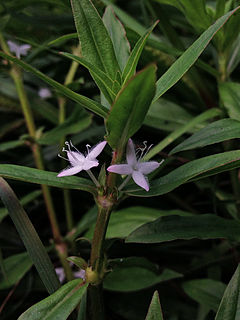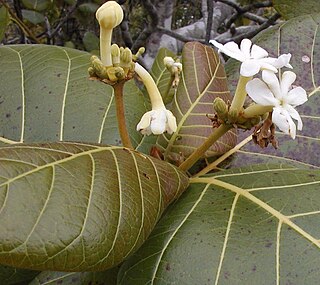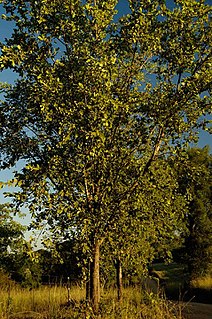
The Rubiaceae are a family of flowering plants, commonly known as the coffee, madder, or bedstraw family. It consists of terrestrial trees, shrubs, lianas, or herbs that are recognizable by simple, opposite leaves with interpetiolar stipules and sympetalous actinomorphic flowers. The family contains about 13,500 species in about 620 genera, which makes it the fourth-largest angiosperm family. Rubiaceae has a cosmopolitan distribution; however, the largest species diversity is concentrated in the tropics and subtropics. Economically important species include Coffea, the source of coffee, Cinchona, the source of the antimalarial alkaloid quinine, some dye plants, and ornamental cultivars.

Galium is a large genus of annual and perennial herbaceous plants in the family Rubiaceae, occurring in the temperate zones of both the Northern and Southern Hemispheres. Some species are informally known as bedstraw.

Agropyron is a genus of Eurasian plants in the grass family), native to Europe and Asia but widely naturalized in North America.

Diodia is a genus of flowering plants in the family Rubiaceae. It was described by Carl Linnaeus in 1753. The genus is found from southern and eastern United States, South America, Central America, Mexico, the West Indies and tropical Africa.

Psychotria is a genus of flowering plants in the family Rubiaceae. It contains 1,582 species and is therefore one of the largest genera of flowering plants. The genus has a pantropical distribution and members of the genus are small understorey trees in tropical forests. Some species are endangered or facing extinction due to deforestation, especially species of central Africa and the Pacific.

Alberta is a monotypic genus of flowering plants in the family Rubiaceae. Most species have been transferred to the genus Razafimandimbisonia, except for the type species Alberta magna. It is native to KwaZulu-Natal, South Africa and is commonly known as Natal flame bush.

Arachniodes is a fern genus in the family Dryopteridaceae, subfamily Dryopteridoideae, in the Pteridophyte Phylogeny Group classification of 2016. A number of species in this genus are known as "holly ferns".

Erithalis is a genus of flowering plants in the family Rubiaceae. The genus is found from southern Florida to tropical America.

Guettarda is a plant genus in the family Rubiaceae. Most of these plants are known by the common name Velvetseed. Estimates of the number of species range from about 50 to 162. Most of the species are neotropical. Twenty are found in New Caledonia and one reaches Australia. A few others are found on islands and in coastal areas of the Indian and Pacific Oceans.

Augusta is a genus of flowering plants in the family Rubiaceae. It is found in tropical Latin America from Mexico to Brazil and also in the southwestern Pacific.
Colletoecema is a genus of flowering plants in the family Rubiaceae. It is the only genus in the tribe Colletoecemateae. The 3 species are found from west-central tropical Africa to Angola.

Crossopteryx is a monotypic genus of flowering plants in the family Rubiaceae. The genus contains only one species, viz. Crossopteryx febrifuga, which is found in tropical and southern Africa.
Deccania is a monotypic genus of flowering plants in the family Rubiaceae. The genus contains only one species, viz. Deccania pubescens, which is endemic to India.
Dibrachionostylus is a monotypic genus of flowering plants in the family Rubiaceae. The genus contains only one species, viz. Dibrachionostylus kaessneri, which is endemic to Kenya.
Didymochlamys is a genus of flowering plants in the family Rubiaceae. The genus is found from Nicaragua to Guyana and Ecuador.
Dunnia is a monotypic genus of flowering plants in the family Rubiaceae. The genus contains only one species, viz. Dunnia sinensis, which is endemic to Guangdong.
Emmeorhiza is a monotypic genus of flowering plants in the family Rubiaceae. The genus contains only one species, viz. Emmeorhiza umbellata, which is found from northern Trinidad to tropical South America.
Pseudopogonatherum is a genus of Asian and Australian plants in the grass family.
Trailliaedoxa is a monotypic genus of flowering plants in the family Rubiaceae. The genus contains only one species, viz. Trailliaedoxa gracilis, which is endemic to south-central China. It is also the only species in the tribe Trailliaedoxeae.
Greenea is a genus of flowering plants in the family Rubiaceae. The genus is found from Indo-China to Sumatra. It is named in honor of Benjamin D. Greene.











